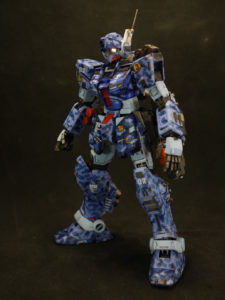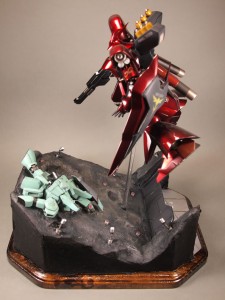The previous day while at the supermarket, I decided to try my hand at making lasagna. Having just had a wonderful lasagna from Angelini Osteria, a quick search pulled up a “recipe”. It is as good a starting point as any, but I’m making my own little modifications to the basic recipe as I go along. Hsiang-Wei(gtetra) came over to work on his Gaplant for which he pretty much finished painting and only requires the clear coats and decals to finish up the sucker.
With the Gaplant’s paint completed, gtetra couldn’t help but put the sucker together. At this point, this is a major milestone and accomplishment. Seeing it together is a nice sight, so I snapped a few quick shots.
Ok, on to the lasagna. The first part of the process is to make the ragu, which is the Italian term for a meat sauce. The ragu can be broken down into three main parts, the meats, the aromatics, and the liquids. Starting off with the meats, I use a half pound of chicken livers, half pound of veal, and half pound of beef. The meats are cut into workable chunks.
Then using meat cleavers, they are grounded up and set aside.
Next up are the aromatics. Typical Italian cooking calls for the use of three aromatics: onions, carrots, and celery; chopped finely and cooked together, the trio is referred to as the soffritto. I added some additional flavorings such as some chopped garlic. Chopped, I have 1 onion, 2 sticks of carrots, and 2 stalks of celery, along with a handful of garlic. The mixture is cooked with a stick of butter for about eight minutes.
The ground meats are then added to the soffritto, and cooked through, which takes about 5 minutes or so. The meats are stirred and broken up to prevent clumping.
In a separate bowl, 2 cups of water and a quarter cup of tomato paste are mixed together, then added to the cooking meat mixture. The mixture is brought to a boil. Once boiling, the heat is dropped to medium low and the mixture simmers for five minutes. At this point, I decided to add a few table spoons of balsamic vinegar, some thyme, oregano, and a few bay leaves as well as a small amount of salt and pepper just to add some extra flavoring to the ragu.
Next I added in a cup of dry red wine and brought it back to a boil. When the boil is reached, the temperature is again dropped to low and the mixture is set to simmer until almost all the liquid has evaporated. This will take about an hour or so. Make sure the heat is low so that the ragu does not burn and stir every now and then.
The ragu is done. The great part about this is that I can make this ahead of time. Let it sit and cool, then refrigerate it until I want to use it. This is a great base meat sauce for may Italian dishes. There are still two more parts that need to be made to complete the lasagna.



















i like the trend im seeing in some of the gundam blogs with modeling and cooking. its been happening to me too!
very informative about the 3 parts of the ragu. i think i enjoy your cooking sections as much as the gundam ones!